
Original Link: https://www.anandtech.com/show/502
Athlon Cooler Roundup (March 2000)
by Tillmann Steinbrecher on March 13, 2000 12:00 PM EST- Posted in
- Cases/Cooling/PSUs
A few weeks ago, we published an Athlon cooler roundup, a comparison of ten high-end heatsinks. By now, three new interesting Athlon coolers have appeared on the market - so it's time for a small update. We're having a look at two dual fan units from RDJD and a dual fan heatsink from Vantec.
The testing methodology for this test has been described in the heatsink testing methodology article.
Test with "simulator"
|
Heatsink
|
Temperature |
|
Vantec
|
|
|
RDJD K703
|
|
|
RDJD K702
|
|
|
Alpha P7125
YS Tech fans |
|
|
Global WIN VOS32
|
|
|
Alpha P7125CM60
Sanyo Denki fans |
|
|
Global WIN FKK32
|
|
|
Montac ArcticCircle
(1)
|
|
|
Global WIN FKK50
|
|
|
Global WIN VEK32
|
|
|
TennMax VIVA STF
|
|
|
RDJD K701
|
|
![]() simulator temperature
simulator temperature
![]() simulator temperature (from
Feb. 00 roundup)
simulator temperature (from
Feb. 00 roundup)
All values in deg C.
(1)The Montac ArcticCircle, unlike other heatsinks in this comparison, should be mounted directly on the CPU core, without the Athlon thermal transfer plate. This improves performance; the simulator test does not take this into account. Real-world performance might therefore be better.
Note that the tested heatsinks already represent a selection of some of the best available heatsinks; this means that even heatsinks that reached relatively high temperatures in this test might still be above-average when compared to cheaper heatsinks targeted at OEMs. All of the heatsinks tested would allow an Athlon-650 to run perfectly stable at 750MHz without overheating.
All three heatsinks tested in this update did not fit the test motherboard (ASUS K7M), so we're only publishing test results obtained with the "CPU simulator". Keep in mind that today, "ASUS K7M compatibility" is not a very important factor for those who plan to buy a new Athlon system in the near future, since the K7M is probably close to the end of its life cycle, and the new Athlon motherboards that are about to appear on the market cause less problems with heatsink compatibility than the good old K7M.
The RDJD K703
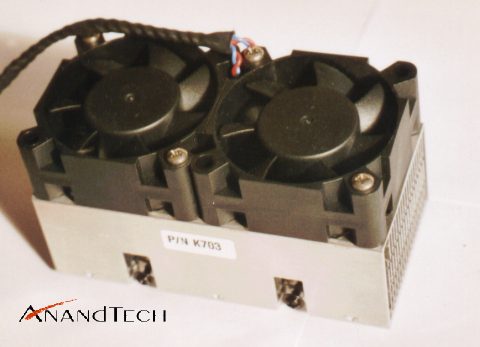
Here's a closer look at the bonded fin heatsink:
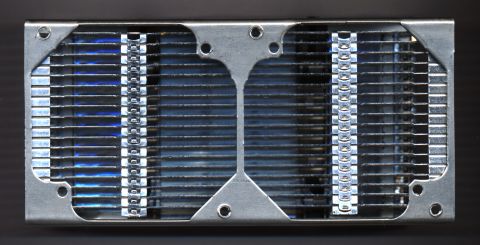
The K703 will not fit the
ASUS K7M and might not fit other Athlon boards.
The fans
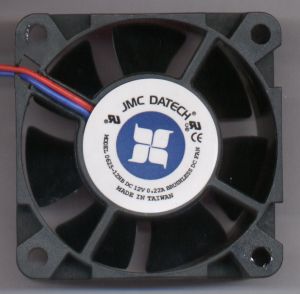
The K703 comes with JMC DaTech 60mm fans. Each fan moves 21CFM; the noise level is acceptable - the JMC fans are not as noisy as the YS Tech fans used on Global WIN heatsinks, but they are also less efficient. Unfortunately, the fans do not support rpm monitoring.
Installation
The K703 uses the same great clips we already know from the K701.They allow easy installation and secure mounting. A possible source of problems might be the fan's power connector: The fans do not have a three-pin MOLEX connector but, instead, a two-pin connector. Therefore, you must take great care to plug the fans in correctly. Also, the two-pin connector might not fit very well on some motherboard or Y-adapter MOLEX connectors. The K703, like all other RDJD Athlon heatsinks, comes with a preinstalled thermal pad. For better performance, the pad should be removed and thermal compound should be used instead. All test results were obtained using thermal compound.
Conclusion
Considering the remarkable performance of the single fan RDJD unit in the previous Athlon heatsink test, expectations for RDJD's big dual fan heatsink were high. However, the K703's performance turned out to be quite disappointing, especially considering the cooler's price of about $35. You can definitely get better performance at a lower price.
| RDJD K703 at a glance |
|
Fans:
Two 60x25mm JMC
Fan
rpm (Mfr spec): 4200
Weight: 360g |
| Advantages |
|
| Disadvantages |
|
The RDJD K702
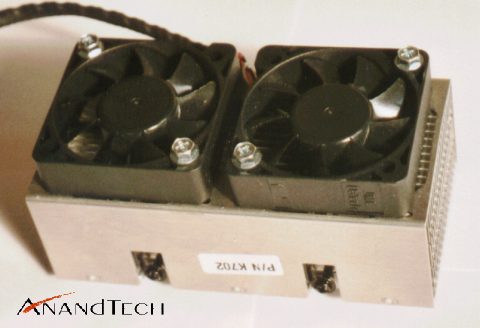
Despite the small fans, the K702 will not fit the ASUS K7M.
The fans
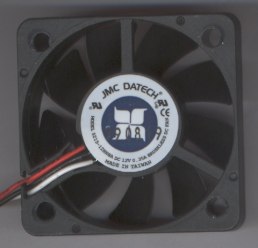
The K703 comes with two JMC DaTech 52mm fans. The K702 is not very noisy; it is among the most silent dual fan heatsinks in this comparison. Still, the heatsink design is not optimized for low noise - the slot between the two fans acts as a "whistle". If you put a piece of duct tape between the two fans, you can reduce the noise level a bit.
Both fans are connected
to a single three-pin MOLEX connector, which means that only one fan can be
rpm-monitored.
Installation
The K702 uses the same great clips we already know from the K701, so all comments about installation made in the K701 review also apply.
Conclusion
Already, the K703 with its 60mm fans wasn't exactly convincing performance-wise; the K702, with smaller fans, is even less efficient. Priced at $30, the K702 cost as much as a VOS32 (which provides way better cooling), so the K702 isn't the cooler to choose if you're looking for a good price/performance ratio.
| RDJD K703 at a glance |
|
Fans:
One 52x10mm JMC
Fan
rpm (measured): 5921
Weight: 270g |
| Advantages |
|
| Disadvantages |
|
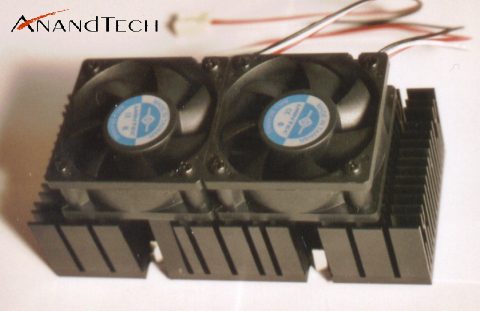
The Vantec cooler does not fit the ASUS K7M. The heatsink Vantec is using looks
very similar to the Global WIN FKK50:
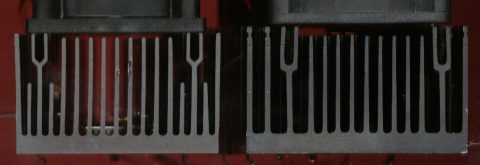
Almost twins, but from different
manufacturers: Vantec (left) and Global WIN FKK50 (right) side by side. The
FKK50 is slightly larger, but the Vantec unit has finer fins.
The fans
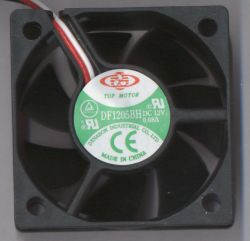
Vantec uses 50x20mm Top
Motor fans for their dual fan Athlon heatsink - and these fans clearly outperform
the 50x15mm fans found on the Global WIN FKK50. The noise level is similar
to the FKK50. Both fans support rpm monitoring; Vantec includes a MOLEX Y-adapter
with their heatsink, so you can either connect both fans to
a single fan connector and have rpm-monitoring for one of them, or you can
connect both fans to your motherboard if you have enough free fan connectors.
Installation
Vantec's heatsink uses clips with large handles that can be very easily installed and uninstalled, without any tools. The heatsink comes with a large thermal transfer pad - Vantec is one of the few manufacturers that are still using graphite pads as an interface material; most other manufacturers have switched to "high tech" thermal pads that have better thermal transfer characteristics. Removing the pad and using thermal compound instead is always a good idea, but with the Vantec heatsink this is especially important, since the graphite pad is even worse than other pads.
Conclusion
This heatsink isn't the supreme product, but the performance is above average. For those who have considered buying a Global WIN FKK50, the Vantec unit is the better choice - the heatsink is very similar, but the fans Vantec is using are stronger.
| Vantec K7T-5030 at a glance |
|
Fans:
Two 50x20mm Top Motor
Fan
rpm (measured): 6016
Weight: 285g |
| Advantages |
|
| Disadvantages |
|
Does this mean that RDJD's "bonded fin" heatsink design is bad? Definitely not. RDJD has proved with the K701 that their design makes sense. But the problem with the K702 and K703 is that their heatsinks are based on a design that was developed for single fan coolers. The airflow inside the dual fan coolers, especially in the center, is less than ideal. If RDJD came up with a heatsink design optimized for a dual fan configuration (with a different orientation of the fins, for example), then they could definitely produce top-performing coolers. But let's see what the future will bring...
As for the Vantec cooler: Although it certainly isn't the most efficient Athlon heatsink available - nobody would have expected that - it provides good performance, making it even suitable for overclocking. Whether this heatsink will be successful depends on its price - and it's probably going to be very attractive.
Conclusion
This update to the Athlon cooler roundup doesn't change much about our heatsink buying recommendations for overclockers: VOS32(-plus) or Alpha K7125/YS Tech for hardcore overclockers, ArcticCircle or Alpha P7125/Sanyo Denki for noise-sensitive overclockers.
Only for budget-conscious overclockers, the new recommendation is to pick the Vantec dual fan cooler over the FKK50.







